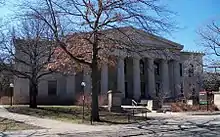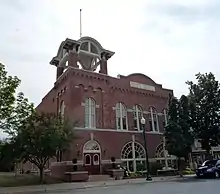Charles Sumner Sedgwick
Charles Sumner Sedgwick[note 1] (1856 – March 12, 1922)[1] was an American architect based in Minneapolis, Minnesota.[2]
Personal life
He was born in New York State.[3] His wife, Mary D., was born in the 1850s and died in 1920.[4] Sedgwick died in 1922 at St. Barnabas Hospital in Minnesota, after several years of illness with Bright's disease.[5]
Career
He started his career as an architect in Binghamton, New York and moved to Minneapolis in 1884[6] and completed several projects in the city[7] and surrounding areas and states. Several of his works are listed on the National Register of Historic Places.[8]
Works
Sedgwick was most known for his residential commissions, but also designed churches, school buildings, and commercial structures.[3]

Burton Hall at the University of Minnesota
- George W. Baird House (1886), Edina, Minnesota, NRHP-listed
- Como Congregational Church (1886), Minneapolis, Minnesota
- George R. Newell House (1888), 1818 LaSalle Ave., Minneapolis, MN (Sedgwick, Charles), NRHP-listed[8]
- First National Bank (1889), 501 St. Germain St., St. Cloud, MN (Sedgwick, Charles), NRHP-listed[8]
- Old Arkansas City High School (1890), Arkansas City, Kansas, formerly the Arkansas City High School building and now Ireland Hall at Cowley Community College; NRHP-listed[8]
- Andrew Presbyterian Church (1890), at Fourth Street and Eighth Avenue, Minneapolis,[3] patterned after St. Giles in Scotland. Demolished c.2002.[9]
- Nehemiah P. Clarke House (1892–93), 356 3rd Ave., S., St. Cloud, MN (Sedgwick, Charles S.), NRHP-listed[8][10]
- Westminster Presbyterian Church (1897), 1201–1213 Nicollet Mall with Warren H. Hayes,[3] NRHP-listed
- Dayton's (1902) at 700 Nicollet Mall in Minneapolis (later converted to a Macy's before closing down)
- Burton Hall (University of Minnesota) interior at the University of Minnesota (1895) with Leroy Buffington designing the exterior. The building was formerly used as a library[11]
- Budge Hall (1899 – demolished 1981) and Science Hall (renamed Minard Hall in honor of Dean A. E. Minard) at North Dakota State University[12] Minard Hall has been added on to and extensively renovated over the years.[13]
- William F. Bruell House (1902), Address Restricted, Redfield, South Dakota (Sedgwick & Saxton), NRHP-listed[8][14]
- Four story commercial building at 256 1st Avenue North (1902) in Minneapolis
- Morris Carnegie Library (1905), Nevada and 6th Sts., Morris, MN (Sedgwick & Saxton), NRHP-listed[8]
- Old Waconia City Hall (1909), 9 W. 1st St. in Waconia, Minnesota, NRHP-listed[8][15]
- First Lutheran Church (1916) 434 First Street Southwest in Blooming Prairie, Minnesota[16]
- Park Avenue Covenant Church, Minneapolis
- Park Avenue Congregational Church, at Park and Franklin Avenues, Minneapolis[3]
- Lowry Hill Congregational Church, at Dupont and Franklin Avenue, Minneapolis[3]
- Fourth Baptist Church, at 2105 Fremont Avenue North, Minneapolis[3]
Notes
- In some sources, his name has been incorrectly presented as Charles Sedgewick
References
- "Sedgwick, Charles S. (1856–1922) – Philadelphia Architects and Buildings". www.philadelphiabuildings.org. Retrieved 25 March 2018.
- GmbH, Emporis. "Charles S. Sedgwick – Companies – EMPORIS". www.emporis.com. Retrieved 25 March 2018.
- Charlene K. Roise; Christine A. Curran (February 1998). "National Register of Historic Places Inventory/Nomination: Westminster Presbyterian Church". National Park Service. Retrieved March 25, 2018. With eight photos from 1998.
- gravestone, (birth year not completely legible)
- The American Contractor - Volume 43 page 39 https://books.google.com/books?id=CztYAAAAYAAJ 1922
- The Lowry Hill Neighborhood - Historical Context Study, prepared for the Lowry Hill Residents Inc. by Landscape Research LLC, 2006
- Millett, Larry (25 March 2018). "Once There Were Castles: Lost Mansions and Estates of the Twin Cities". U of Minnesota Press. Retrieved 25 March 2018 – via Google Books.
- "National Register Information System". National Register of Historic Places. National Park Service. July 9, 2010.
- "Twin Cities Houses of Worship: Andrew Presbyterian Church, Minneapolis". University of Minnesota. Retrieved March 25, 2018.
- "Owner worked hard to restore historical Clarke home". Retrieved 25 March 2018.
- "Burton Hall – Iconics – University of Minnesota". iconics.cehd.umn.edu. Retrieved 25 March 2018.
- North Dakota History – Volume 69 page 4
- "Minard Hall – North Dakota State University Walking Tour – PocketSights". pocketsights.com. Retrieved 25 March 2018.
- Swisher, Kaija (24 January 2014). "Bruell house". Black Hills Pioneer. Retrieved 25 March 2018.
- McElveen, Thomas C. (1982-09-15). "National Register of Historic Places Inventory—Nomination: Waconia City Hall". National Park Service. Retrieved 2018-03-24. Cite journal requires
|journal=(help) - Lathrop, Alan K. (25 March 2018). "Churches of Minnesota: An Illustrated Guide". U of Minnesota Press. Retrieved 25 March 2018 – via Google Books.
This article is issued from Wikipedia. The text is licensed under Creative Commons - Attribution - Sharealike. Additional terms may apply for the media files.

